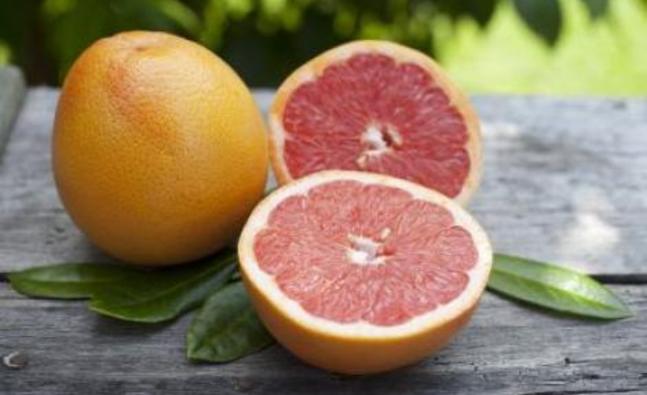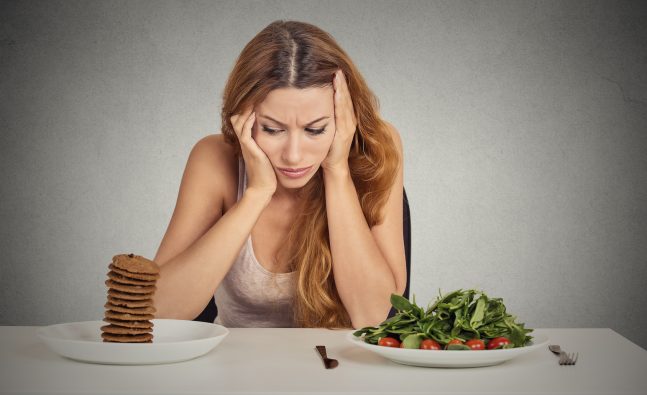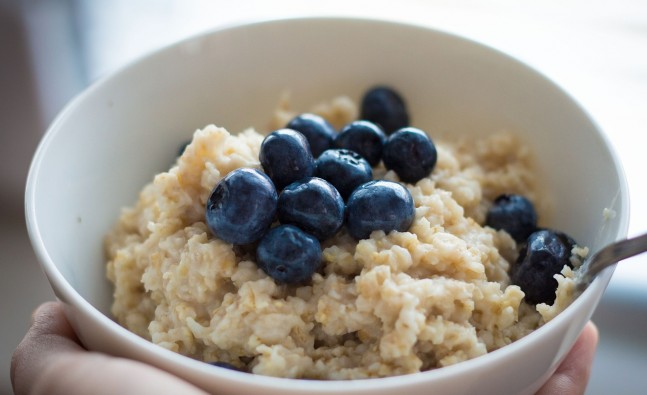Does High Protein Diet Help You Lose Weight?
One thought of our weight and the word ‘stubborn fat’ is the first one to pop in our minds! How many of you have tried to exercise with little difference to show for it? Have you ever tried to tone your body just by adopting a few simple diet changes?
This post tells you how you can shed those pounds with a high protein diet! Would you like to know more about high protein diet and weight loss? Read on!
Proteins In The Body
Proteins are extremely necessary to the normal functioning of the human body. They constitute the backbone of all essential components, including hormones and enzymes (1). They are also a vital part of body organs, particularly muscles, the growth of which burns calories and aids fat loss.
Our body breaks down the proteins and amino acids from food inside the liver, where they are converted to precursors that are supplied across all organs. Hence, a high protein diet is crucial to not just for basic functions, but also for cell repair and health rejuvenation as well.
Proteins In Diet
A healthy individual can obtain the required amount of protein from a balanced diet that includes all food groups. As per the daily recommended allowance, an adult male requires 56gm of protein every day, while an adult woman needs 46gm per day. Children require around 50gm of protein a day. It is advised that more than 10% and less than 30% of your daily calories should be obtained from protein. A diet exceeding 30% is considered a high protein diet.
Diet Sources Of Protein
A high protein diet is an excellent method to lose weight, as it literally encourages the brain to enter a fat loss mode. Some of the best sources of protein are eggs, milk, cheese, tofu, soy, chicken, lean meat, seafood, lentils, beans, nuts and grains (2). Experts suggest 3-4 servings of any of these items during the day to obtain plenty of protein (3).
High Protein Diet For Weight Loss
Weight loss with high protein diet is surely a successful mantra. But it is not enough. What about the other food groups? Eating only a protein rich diet can be more harmful than helpful. A balanced diet is the key to effective weight loss. When we talk about a high protein diet for weight loss, one needs to keep in mind certain points.Carbohydrates and fats are also absolutely essential for the normal functioning of our body. A protein rich diet should include these food groups (carbohydrates and fats) in reduced amounts, preferably in a healthier variety. Do not starve yourself or it could lead to hypoglycemia, health complications and a resultant weight gain. A balanced diet regimen will result in genuine weight loss that will be long term, unless your food habits change back to what they were before. Good carbohydrates can be obtained from vegetables, fruits, whole grains, legumes, beans, yogurt and low-fat milk. Some of the healthy fats are sourced from nuts, nut butters, olives, seeds, avocados, fish and extra virgin olive oil.
Proteins From Vegetarian Sources
Who says a diet devoid of meat does not meet high protein requirements? Meat eaters always wonder where vegetarians get their proteins from. It would be surprising to know for some that plant based proteins are healthier compared to animal based proteins. This is because animal and plant proteins are digested differently in the human body.
It is easy to obtain your daily dose of protein from exclusively vegetarian sources as long as you eat a range of food items. It is recommended that a vegetarian adult male requires 63gm of protein per day while a vegetarian adult female requires 52gm per day (4). Here are the high protein vegetarian diet sources.
1. Cottage Cheese


Each half cup of cottage cheese contains 13gm of proteins. It is a great non-expensive healthy food item. In addition to protein for muscles, cottage cheese contains calcium for good bones. You can combine it with vegetables or fruit to make it into a great dish. Other forms of cheese also have good amounts of protein. It is best taken in its low fat version (5).
2. Soy Milk
Soy milk is the perfect option for those going for non-dairy milk. The product is rich in protein at about 7gm per serving. Since vegetarians are advised to have 2-3 servings of protein a day, soy milk and other soy products will easily fulfil your daily requirements. Soy milk also provides potassium (6).
3. Almonds
A handful of almonds is all you need to grab 6gm of protein. They can be added to salads and other dishes for extra flavor. Almonds also provide monounsaturated fats that are good for the heart (7).
4. Greek Yogurt
Besides being extremely delicious, greek yogurt is packed with protein. It is a creamier version of plain yogurt with less than half its sugar and carbohydrates. A single serving gives you 15gm of protein.
5. Peanut Butter


Two spoons of peanut butter and you are set for the day with 8gm of protein. The traditional toast can be flavored with this all time favorite or the peanut butter can be added to protein shakes or smoothies. Either way, it’s a tasty vegetarian option to eat plenty of proteins.
6. Tofu And Tempeh
Tofu is a good alternative to meat (8). One obtains 11gm of protein from 150gm of tofu in addition to magnesium and iron. It can be added to a variety of food preparations. Tempeh, a chewier version of tofu, contains 15gm of protein in half a cup of serving. It is a healthy choice whether one is a vegetarian or not.
7. Lentils And Beans
Kidney beans, baked beans and dried black beans are particularly good sources of proteins (9). They offer 13-15gm of protein along with fiber. Similarly, a cup a chick peas contains 15gm of protein and is one of the best high protein vegetarian diets. Lentils, rich in iron, also pack equal quantities of protein.
8. Nuts And Seeds
Pumpkin seeds, pine nuts, peanuts, pistachios, walnuts, chia seeds are all high in protein at up to 7gm per serving. They also provide many health benefits as long as the portions are controlled. Nuts are high in calories but otherwise nutritious.
9. Hemp
Hemp is the next best product for those allergic to soy based offerings, containing 3gm protein per serving. This plant derivative provides you with many essential amino acids that the body uses to build muscle. Hemp dairy products and hemp seeds contain fatty acids that greatly improve the immune system.
10. Whey Protein
Perhaps the most popular protein supplement, this milk based protein has many health benefits for your body. Whey breaks down incredibly fast and is rich in BCAAs or (branched-chain amino acids), which are essential in increasing your muscle mass and improving blood flow.
Whey protein is packaged by many organizations and is usually available in all sorts of flavors, like vanilla, strawberry and chocolate. The best way to ensure that you gain muscle mass is by having one glass of whey protein before and after your workout.
11. Quinoa
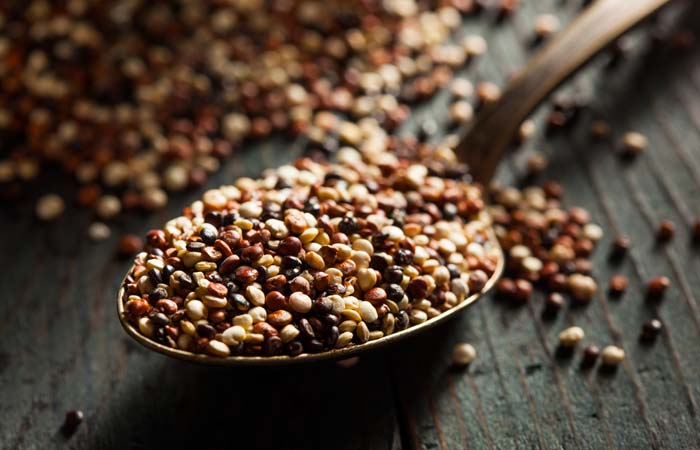

Known as the king of grains, quinoa is indeed a perfect protein. It has the highest percentage of protein content found in a plant source at 16 percent per volume! This means that if you eat just ¼ cup of quinoa, you get 6 gm of protein. But if you want more protein, you can add asparagus, cauliflower, broccoli and sprouted mung bean stir to your diet.
12. Whole Wheat Bread
Whole wheat bread is different from other refined breads in the way it is processed (10). Whole wheat bread and pasta varieties are high in proteins along with other beneficial effects on the health. They can be made a part of any meal and teamed up with other food items for good taste.
13. Casein
The other milk protein apart from whey, casein is also quite essential for muscle gain. Studies conclude that having casein shakes after your workout can help you gain more muscle than people who usually don’t have any protein supplement.
Whey protein also has other effects on the body, like reducing the appetite. This property causes a reduction in food intake when you are on whey, while casein doesn’t have any such effects. This is healthier as when you are aiming to increase body mass, you need to eat a lot. Having whey will reduce your appetite, and between casein and whey, casein is the better choice. It will provide you enough protein and calories without filling you up (11).
Check out what our in-house expert has to say about vegetarian protein sources:
Proteins From Non-Vegetarian Sources
1. Eggs
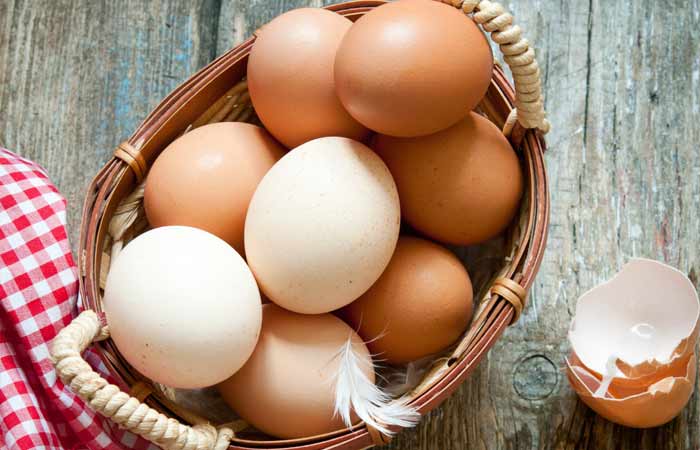

The popular Indian adage, ‘Sunday or Monday, eat eggs every day’, is quite true. Plain egg whites or even whole eggs help you gain muscle mass and improve your strength. A Texas A&M University study concludes that consuming 2-3 eggs daily helps you double your muscle mass in three months (12).
2. Beef
Red meat isn’t really all that popular. It is crammed with saturated fat and cholesterol and is anything but heart-healthy. However, if you are looking for an effective high protein diet for muscle building, then beef is the ideal food for you. The demonized saturated fat and cholesterol help boost your testosterone levels, helping increasing your strength and muscle mass in the process.
3. Omega-3 Fatty Acids
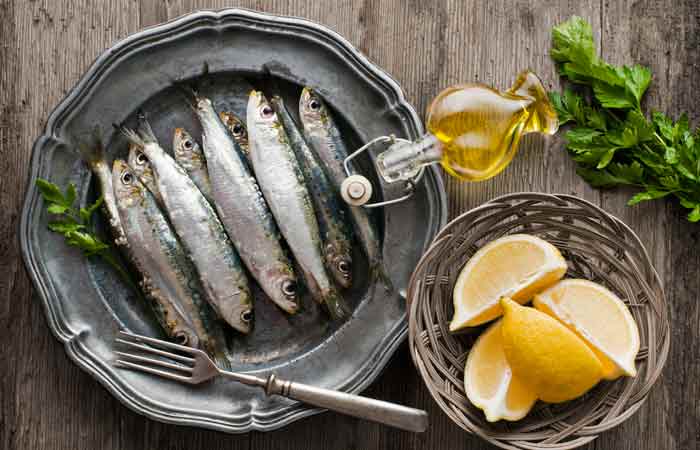

Omega-3 fatty acids help cure inflammation, boost immunity and also help prevent the onset of certain types of cancer. They are also quite essential for many body functions and help you gain muscle due to the presence of the most essential amino acids. You can consume nuts like camu camu, as these contain all the eight amino acids.
Oily fish like Salmon, Tuna, Mackerel and Sardines are also crammed with omega-3 fatty acids. If you are a vegetarian, you can get your dose of omega-3s from most kinds of nuts, like flaxseed and pili nuts, which are excellent sources of vegetable protein (13).
27 Best High Protein Diet Recipes For Weight Loss
Let us now take a look at some delicious high protein diet recipes for weight loss.
1. Cheesy Scrambled Eggs


Any high protein diet, and any day, will have to begin with eggs. It doesn’t take long to prepare this recipe, and the calcium from the cheese is better absorbed because of the vitamin D. As an added bonus, eggs are low in carbohydrates.
Ingredients
- Unsalted butter, 2 spoons
- Diced onion
- 10 beaten eggs
- Quarter spoon salt
- Half spoon ground pepper
- Goat cheese
Preparation
- Melt butter in a skillet over medium heat.
- Add onion, cook for 5 minutes, pour egg mix and stir.
- Add pepper, stir, allow to cook, stir some more.
- Add goat cheese in the end, and serve hot.
2. Chicken Casserole
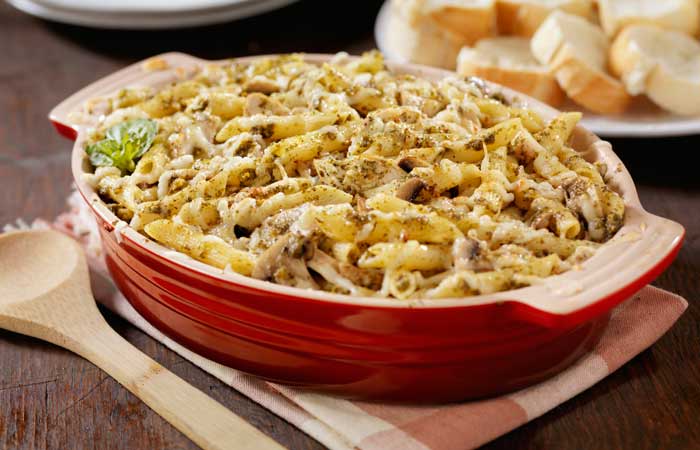

Chicken is an excellent protein source, and casseroles are a family favorite. It offers about 35gm of protein, and one can never get bored of this recipe. It is inexpensive and takes 30 minutes to prepare it at home, allowing you to use healthy products during the cooking process (14). Casseroles have plenty of vegetables that add fiber and nutrients to your diet as well.
Ingredients
- Diced 12 oz cooked chicken breast
- 2 spoons unsalted butter
- 2 spoons all-purpose flour
- Pinch of white pepper
- Skim milk
- 7 oz penne pasta
- 1 spoon grated parmesan cheese
- 2 chopped orange bell peppers
- 1 chopped zucchini
- 2 heads chopped broccoli
- Little amount of cheese and Italian seasoning
Preparation
- Add butter to a preheated sauce pot.
- Once it foams, add milk, and stir until it bubbles.
- Let it simmer for 10 minutes on low flame.
- Now add Italian seasoning, parmesan cheese, and pepper.
- Cook pasta according to directions on package, but add broccoli.
- Later drain the same and then combine it with veggies and chicken.
- After covering the pasta with sauce, place it in a baking dish, sprinkle it with cheese, cover with foil and bake until cheese is melted.
3. Lentil Salad
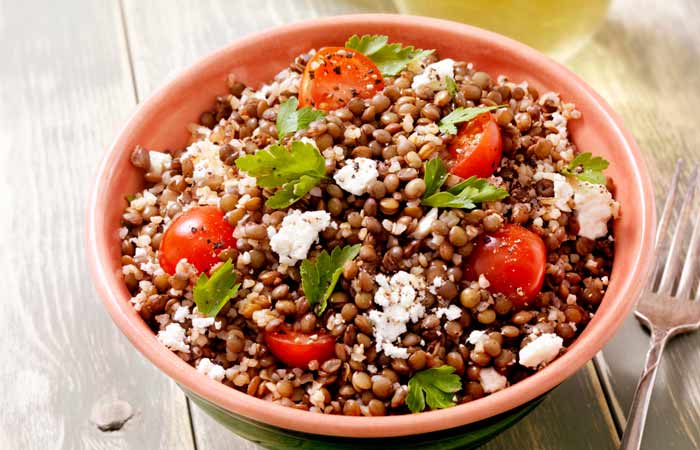

Lentils are one of the best sources of plant protein on the planet. They are not just protein-packed, but are also super easy to be turned into yummy salads.
Lentils may not be the world’s tastiest foods, so you can ‘taste-them-up’ by adding veggies and fruits. You can add lentils to avocados, sources of good quality fats, raw nuts, seeds, and lots of vegetables like beans, and you have a tasty, healthy snack for you to enjoy!
4. Cauliflower Soup
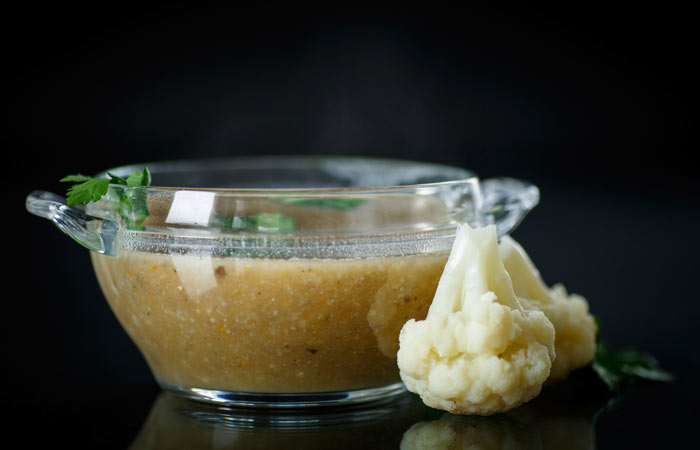

Who would believe that this modest, off-white vegetable can be super healthy and packed with the building blocks of our bodies! Consider this – 1 cup cooked cauliflower equals 28 gm of protein. A healthy way to eat cauliflower is to add other protein and mineral rich veggies and make a soup. Not only will you be getting loads of proteins that way, but you will also be consuming abundant nutrients for keeping you protected against cardiovascular diseases and cancer.
Cauliflower also contains carotenoids and omega-3 fatty acids that reduce inflammation in the body and decrease the risk of heart disease.
5. Roasted Pumpkin Seeds
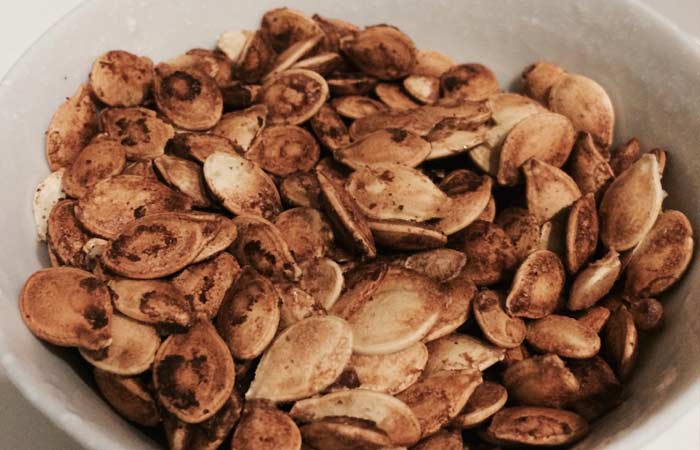

These small, orange seeds pack in 7gm protein per 1oz. and are great for you. Because of their high protein content, pumpkin seeds are an excellent pre-workout snack. They make an exemplary grab-and-go snack after they are washed, dried and roasted. They are also great as a topping for salads and soups.
A word of caution – All nuts and seeds, including pumpkin seeds, are high in calories and fat. Hence, it’s better to not overindulge in them. Remember, you don’t want to pile on fat while consuming more protein, do you?
6. Tofu Tacos
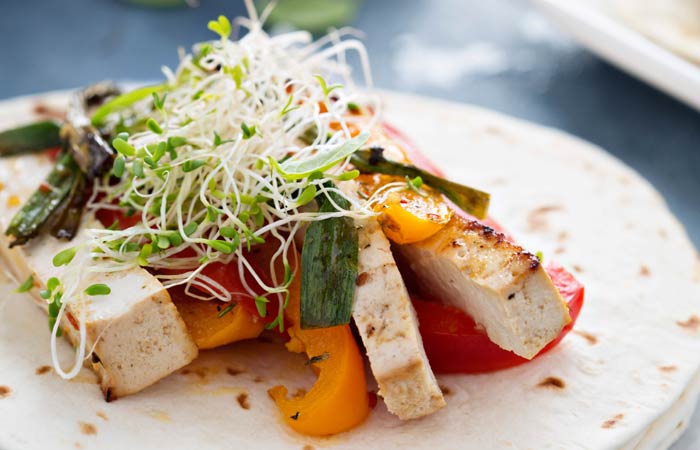

This easy to make recipe is delicious and has 17g proteins per serving. You can store tofu filling for up to 2 days and make tasty tacos anytime you desire.
Ingredients
- 1 pack Tofu
- 2 tsp onion powder
- ¼ cup whole wheat flour
- ¼ cup yeast
- ½ tsp garlic powder
- ¼ tsp turmeric
- 2 tbsp liquid Aminos
- Salsa
- 8 Corn tortillas
Here Is How To Prepare
- Drain tofu and crumble into a bowl.
- Add flour, onion powder, garlic powder, yeast, and turmeric. Stir well and add liquid Aminos.
- Heat a nonstick pan and pour tofu mixture. Cook until it turns brown.
- Serve with tortillas, salsa, or any other topping.
7. Oatmeal Cookies


They are moist with a dash of good flavor. You can add raisins or nuts as you desire. You can also use applesauce to replace butter.
Ingredients
- 4 cups oats
- Half cup egg white
- 3 tsp vanilla extract
- 1 cup unsweetened applesauce
- 8 tsp vanilla Whey-HD protein powder
- 2 tsp olive oil
- ½ cup grated coconut and almonds, each
- 2 tbsp cinnamon
Here Is How To Prepare
- Take all ingredients and mix well.
- Take one tbsp measurement for each cookie.
- In preheated oven, bake for approx. 20 minutes.
8. Blueberry Quinoa Parfait
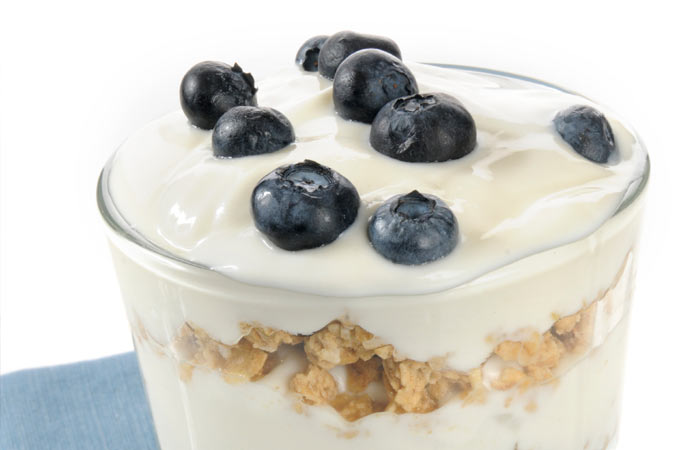

This will give a sweet start to your day with 25 grams of proteins and lots of good carbs. You can use blueberries to make this creamy breakfast.
Ingredients
- 1 cup cooked quinoa
- 2 cup yogurt
- ¼ tsp vanilla extract
- One cup blueberries
- walnuts
- 1/8 tsp cinnamon
Here Is How To Prepare
- Keep quinoa in the fridge for chilling.
- Make parfait by layering of yogurt, quinoa, blueberries, and chopped walnuts.
9. Hard-Boiled Eggs
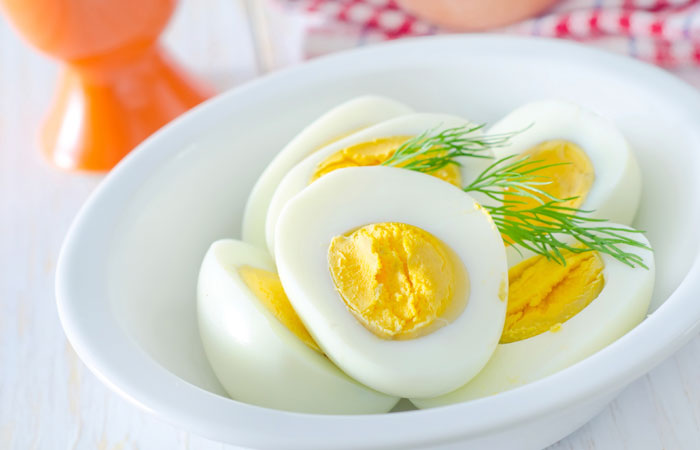

Eggs, especially the yolk, are loaded with nutrients and proteins. This makes eggs one of the best and most inexpensive ways to get a healthy dose of protein. All you have to do is hard boil an egg, slice it, and place it on a slice of whole-wheat bread for a healthy snack on the go.
10. Peanut Butter And Jelly Sandwich
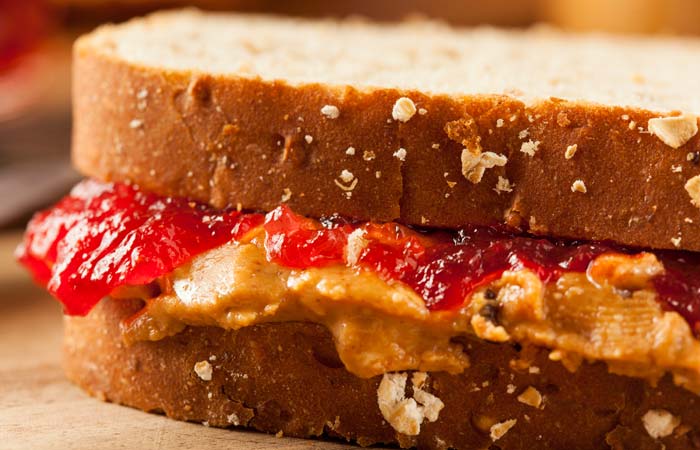

Peanuts have many other benefits due to the presence of a substance called Co-Enzyme Q10, which protects the heart when the oxygen supply becomes low. It also contains Resveratrol, (15), which is a chemical that improves blood flow to the brain and lowers your LDL or bad cholesterol. This is one of the best high protein snacks for kids.
11. Mung Bean Sprouts Salad
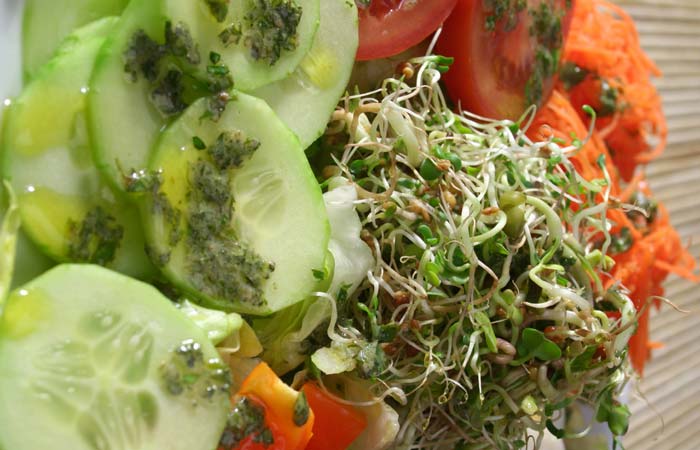

Most beans, including the humble Mung bean, are excellent sources of protein. 1 cup of Mung bean contains 3.16 gm of proteins; it is also low in calories, and is super healthy as Lecithin lowers blood cholesterol levels and reduces liver fat. You can add other sprouts to the mung bean sprouts and enjoy a healthy mid-morning snack.
12. Egg White Frittata
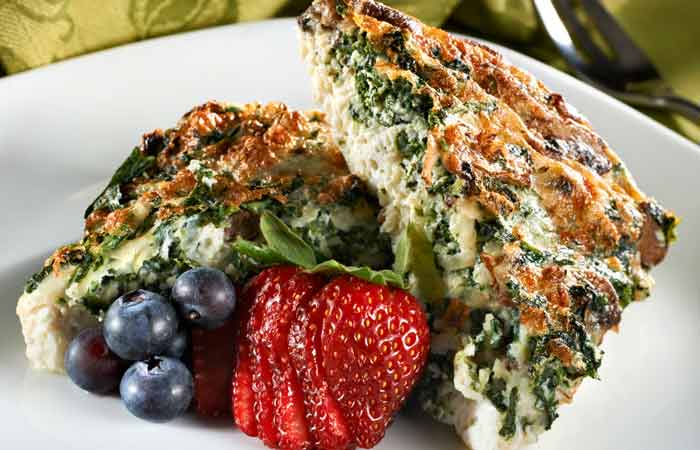

This downy frittata with Mediterranean inputs is low in calories and high in proteins. It offers 21.6 g protein in each serving.
Ingredients
- 8 egg whites
- 2tbsp olive oil
- 1 green and red pepper, each chopped
- ½ cup feta cheese
- ¼ yellow onion
- 2 cups spinach, fresh and washed
- Salt and black pepper, 1tsp each
Here Is How To Prepare
- In a heated pan, sauté onion, pepper for a few minutes until they soften.
- Add salt and pepper.
- Add egg whites and cook for 5 minutes.
- Pour feta cheese and spinach.
- Bake uncovered for 10 min. in a preheated oven.
13. Apple Walnut Oatmeal


This healthy and tasty recipe with loads of nutrients is simple and fast to prepare. It offers 24 grams of protein in one serving. Enough for a day, isn’t it?
Ingredients
- ¾ cup dry oatmeal
- ¼ cup skim milk/ low fat milk
- ¼ cup chopped walnuts
- 1 cup chopped apple
- 1/8 tsp cinnamon
Here Is How To Prepare
- Cook oatmeal with milk.
- Add chopped walnuts and apple.
- Pour cinnamon and a little honey for sweetening.
14. Spinach Stir Fry
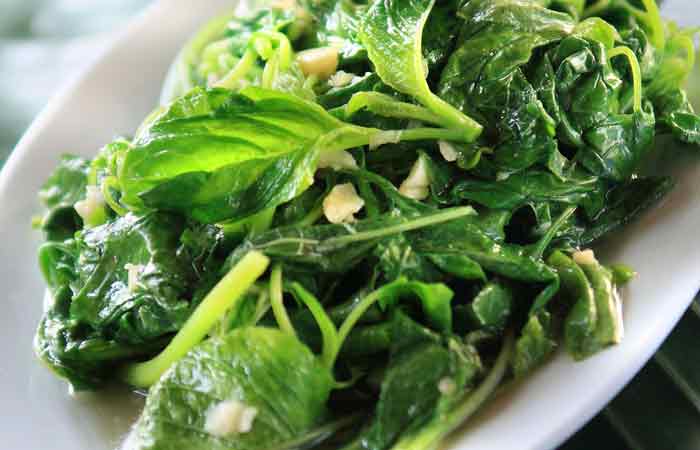

Spinach is the king of greens. This vegetable is excellent as an ingredient in both stir fries and salads. 1 cooked cup of spinach packs in 5.35 gm of protein. And since it is rich in flavonoids and has anti-cancer properties, spinach is good for your skin, eyes, bones, and the brain!
15. Spinach And Egg Wrap
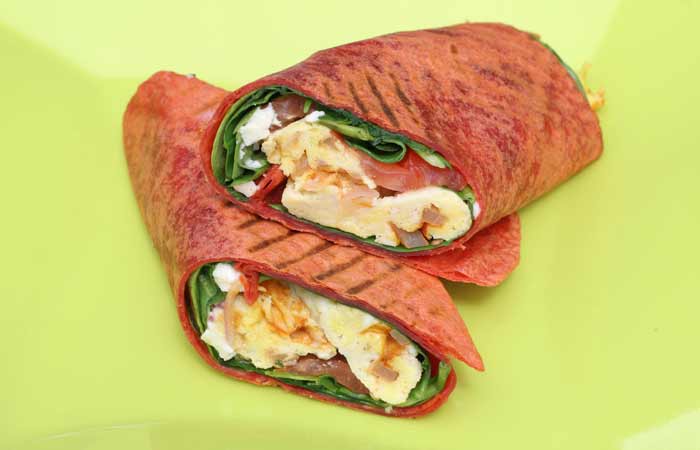

A wrap helps you carry your food on the go, making it a healthy snack choice after breakfast. The wrap has more than 20gm of protein. The recipe packs several vitamins (16) and minerals and also lowers cholesterol, improving heart function.
Ingredients
- Chopped baby spinach
- 4 eggs
- Required salt and pepper
- Cheese
- 1 avocado
- Hot sauce
- Whole wheat tortillas
Preparation
- Add spinach to a nonstick skillet and cook over medium heat.
- After 2 minutes, add the beaten eggs and allow to cook while stirring.
- Place the mixture in the tortillas, season with pepper and salt, top with avocado and fold burrito style.
16. Turkey Meatloaf
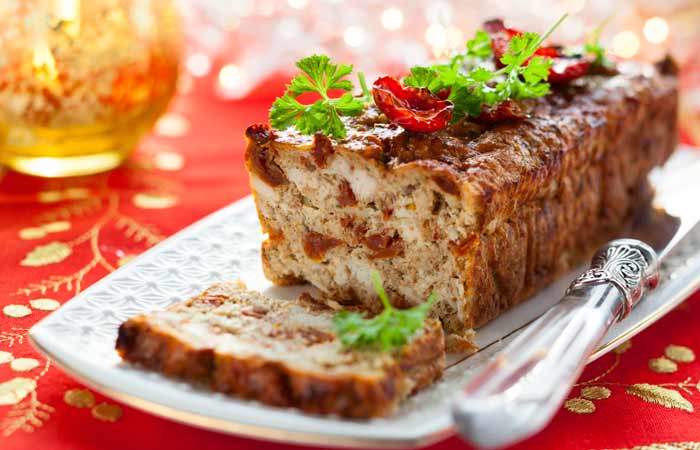

A lean serving of turkey meat is a great choice for a high protein diet. Consumption of just 150 calories of low-fat turkey offers you a comfortable 25gm of protein. Again, eating out may seem convenient, but the varieties could contain hidden unhealthy factors (17). Have flavorful turkey meatloaf at home, served with steamed vegetables and green beans.
Ingredients
- One and a half pounds ground turkey
- Butter
- Chopped onion
- Minced garlic
- 2 spoons butter
- 1 egg
- Half cup of bread crumbs
- 2 spoons Worcestershire sauce
- Catsup
- Salt and black pepper
Preparation
- In a skillet, melt butter and then cook onion and garlic while stirring.
- Let it cool.
- Combine bread crumbs, turkey, egg, sauce, onion, catsup, salt, and pepper.
- Spread remaining catsup on top and bake for 55 minutes.
17. Caesar Salad With Shrimp
The classic Caesar salad can be spruced up to add more protein. Not only does it add more flavor, but shrimp also contains 20gm of protein per 100gm. That makes it an excellent source of dietary protein. Now, you’re armed with more muscle as well as a better heart.
Ingredients
- 1 pound shelled medium shrimp
- 1 loaf bread
- 2 cloves chopped garlic
- 4 spoons lemon juice
- Half cup grated parmesan
- Dijon mustard
- Anchovy paste
- Salt
- Ground black pepper
- Diced lettuce
- 2 cups halved cherry tomatoes
Preparation
- Spread oiled bread on a baking sheet and place in a preheated oven.
- Bake until crispy brown on the outside.
- Meanwhile, put garlic, lemon juice, anchovy paste, parmesan, salt, pepper and mustard and blend until smooth.
- Slowly add oil to the mixture while whisking.
- Add a little oil, salt and pepper to shrimp and broil it for 4 minutes.
- Combine the tomatoes, lettuce, croutons and shrimp in a large bowl and finally, add the dressing.
18. Fish Steak With Onions
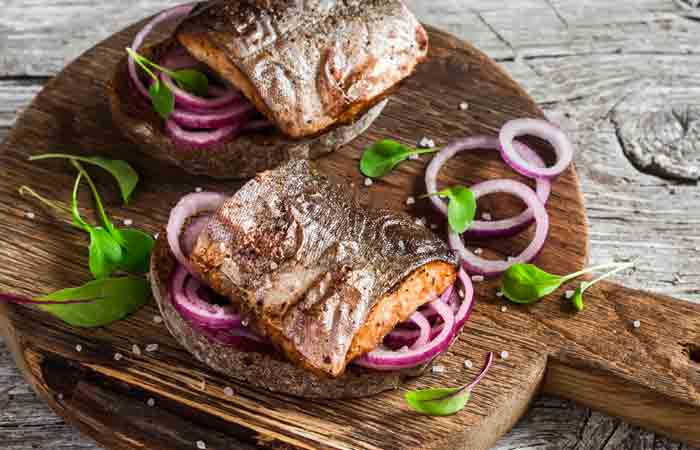

Grilled fish is a tasty way to add more proteins to the diet along with the beneficial omega-3 fatty acids. Fish steak with onions and other veggies will help build muscles, and improves heart and brain functions. This recipe could literally be named brain food (18). Grill-friendly vegetables can be paired with fish such as cod steaks, tilefish or grouper.
Ingredients
- Thinly sliced medium onions
- Peppercorns
- Olive oil
- Bay leaf
- Half cup chicken broth or white wine
- 2 tuna steaks.
Preparation
- Cook onions in large skillet over medium heat.
- When they turn golden brown, add wine, bay leaf, and peppercorns.
- Bring to boil, reduce flame, let simmer for 15 minutes over low flame.
- Move onions to the side, cook tuna in the oil until they become brown on both sides.
- Cook for few minutes until the fish flakes easily, then serve with the onions.
19. Cereal And Granola
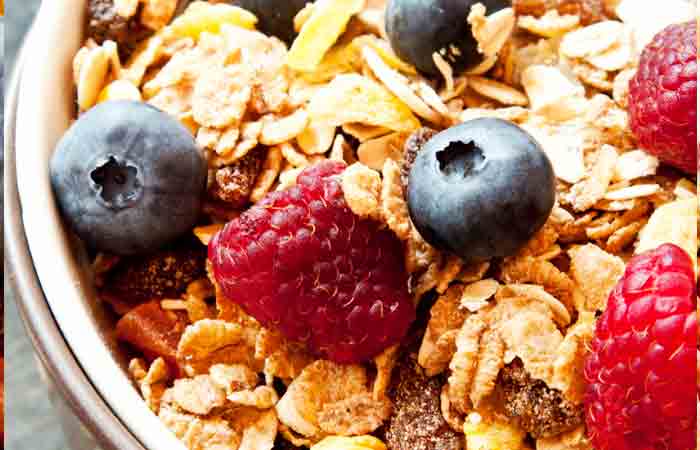

Wheat-based cereals are good sources of protein as well. They contain an average of 3 to 6 gm of protein per cup. 1 cup of cereal eaten dry or with 1/2 cup of milk will serve you as a protein-rich snack at any time of the day. If you want more proteins, you can have 1/2 cup of granola containing 4 gm of protein as a protein-rich snack.
20. Wheat Free Pancakes
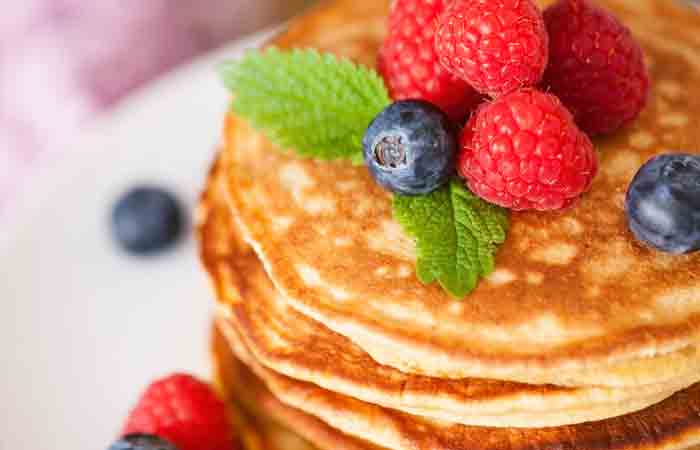

Your breakfast cravings will become more fun with this high protein Indian breakfast. These hot pancakes are low in carb, high in fiber and proteins providing 6 grams of proteins per serving.
Ingredients
- 3 cup of almond meal
- 1 tbsp flax seeds (ground)
- ½ tsp salt and baking soda, each
- 3 eggs
- ¾ cup unsweetened coconut milk/almond milk
- 2 tbsp olive oil/ coconut oil/ melted butter
Here Is How To Prepare
- Mix almond meal, salt, flax seeds, and baking soda in a bowl.
- Whisk eggs with milk and oil/butter.
- Add flour mixture to egg and whisk thoroughly to have a proper consistency for pancakes.
- Heat oiled skillet on medium flame. Pour batter into it.
- Cook for three minutes and flip to ensure even cooking.
- Serve these delicious pancakes with Greek yogurt or maple syrup to add sweetness.
21. Cheesy Egg Sandwich


This healthy sandwich is delicious that you will love it every day. It offers you 40% more proteins at 25 grams as compared to any other sandwich.
Ingredients
- 1 egg
- 1 whole wheat English muffin
- ½ cup low fat cheese
Here Is How To Prepare
- Boil the egg and toast the muffin.
- Cover the top of muffin with cheese.
- Top with sliced egg and your protein rich breakfast gets ready!
22. Mediterranean Sandwich
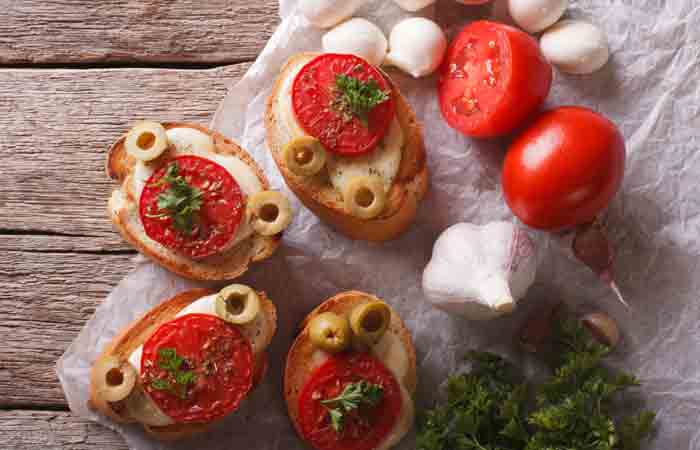

With lots of Mediterranean flavors, this sandwich will suffice your protein requirement by offering 22 grams per serving.
Ingredients
- Whole wheat Pita bread
- 4 tbsp Hummus
- Tomato slices
- 1 ounce goat cheese
- ¼ cup sliced almonds
Here Is How To Prepare
- Take the slice of Pita bread and layer with hummus.
- Top it with tomato slice, cheese, and almonds.
- Serve it fresh.
23. Beef Or Turkey Jerky
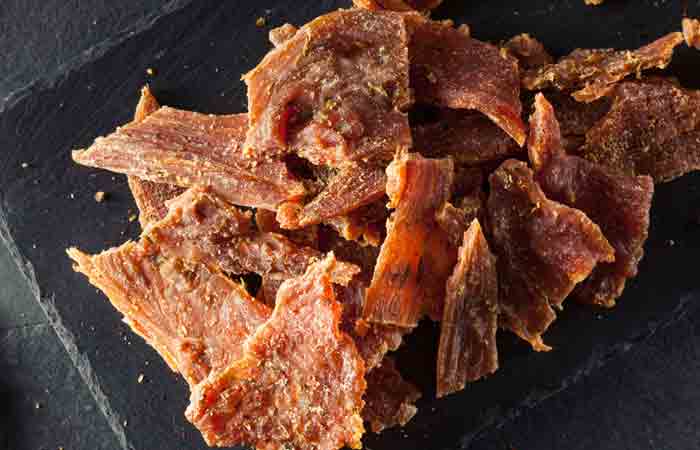

This snack is full of protein and is super tasty. Just 1 serving gives you 9 gm of protein. Just make sure that you choose a low-sodium and preservative-free variety of jerky.
24. Cottage Cheese And Grapes
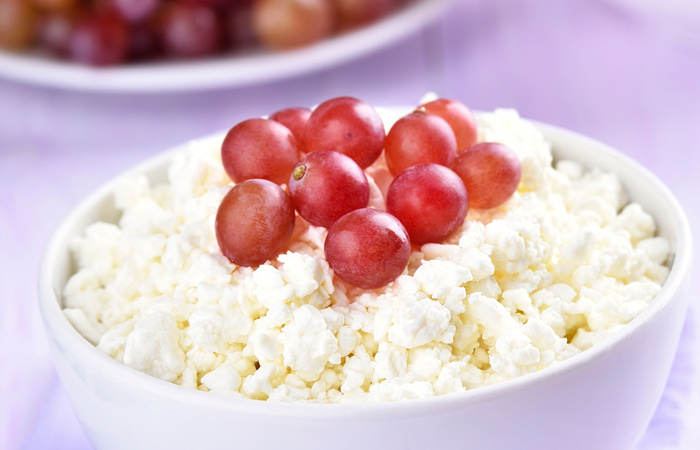

Cottage cheese is a good option for protein. You can add cinnamon and grapes to cottage cheese for an easy-to-make high protein snack. Cheese on its own is a good source of protein and can be packed in your lunch box for a good snack. Just take care to choose a low-fat and hard cheese, like the mozzarella string cheese for making the snack. We also recommend cottage cheese as it is also an excellent source of protein. Just half a cup of cottage cheese has as much as 14 gm of protein.
25. Tofu Sticks
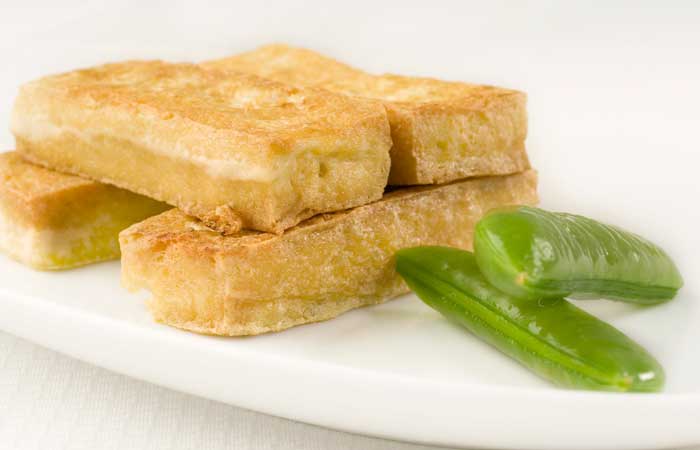

Tofu is a great source of proteins and an excellent alternative for vegetarians. Low in fat and high in isoflavones (19), tofu has many health benefits, especially for women.
What makes tofu even more appealing is that it can be cooked in different ways. This soybean-based protein snack called Tofu isn’t just for making stir-fry; it can also be sliced into sticks and baked to make tofu sticks, a high–protein snack. If you want to spice tofu sticks up, all you have to do is serve them with spicy teriyaki sauce.
26. Chia Crunch
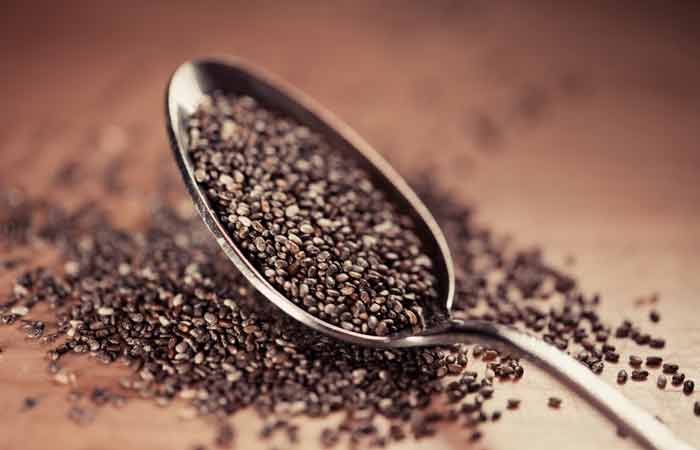

Chia seeds are enriched with Omega 3 fatty acids, fibers, and proteins. This super food is a definite entrée to the breakfast recipes with 22 grams protein in each serving.
Ingredients
- 1/3 cup cooked quinoa
- ¾ cup Greek yogurt
- 2 tsp Chia seeds
Here Is How To Prepare
This simple recipe requires you to mix all these ingredients and just gorge upon its mouthwatering taste.
27. Paleo Breakfast Bowl
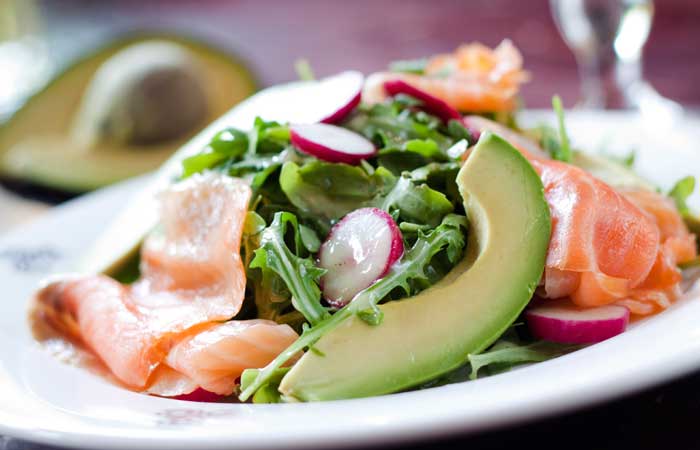

This low carb breakfast is perfect for Paleo dieters. It has omega-3 fatty acids and 22.7 g of proteins to energize your mornings.
Ingredients
- 2 eggs
- 2 ounce smoked salmon
- ½ cup arugula
- ¼ cup avocado
- Ground pepper and fresh lemon juice
- 1 tsp ghee
Here Is How To Prepare
- Heat ghee in a non-stick pan and add scrambled eggs.
- Pour other ingredients in a bowl. Sprinkle with lemon juice and pepper.
- Slide cooked eggs into this bowl and enjoy your hearty breakfast!
10 Unexpected Side Effects Of High Protein Diet
1. Protein Is Replacing Your Muscle
Seems farfetched? There is a direct co-relation to high protein diet and a reduction in muscle mass. We all require a crucial amount of protein, but beyond that, its excess is converted to sugar and later fat. Now, a protein rich diet lacks carbohydrates, which translates to lesser energy, lesser activity and fewer demands on the muscles. As you don’t burn calories, your lean muscle mass is at a risk of shrinking.
Muscles require glucose from carbohydrates to function normally, particularly for high-intensity activities (20). So does the brain. Having considerably lesser energy coupled with increasing weight from the extra protein is surely detrimental to your health. It makes you both fat and tired.
2. Makes Blood More Acidic
Too much protein in the diet forces the body to derive its fuel by breaking down proteins and fats. Hence, ketones are produced, as certain parts of the body like the brain cannot use fats as fuel. Now, there are certain internal mechanisms to control ketone production, but a high protein diet results in ketoacidosis. It is a condition that ultimately leads to kidney damage and even death (21).
In the short term, it makes the blood too acidic and results in bad breath.
3. Gives Kidney Stones
Protein-rich diets are proven to cause kidney stones and various other kidney problems (22). The kidneys filter proteins, which puts the organs under immense stress when on a high-protein diet. The effect of high protein diet on kidney function is severe in the long term. Those with renal abnormalities were observed to have faster deterioration in kidney function if a protein rich diet was taken.
According to researchers, protein from animal sources is more harmful than the same from plant sources. This is because animal protein contains purines, which indirectly lead to the formation of kidney stones.
4. Causes Bone Loss
High protein content in your body causes the calcium to leach from your bones (23). Alternately, calcium is also lost through the urine and excreted via the kidneys much like proteins. Urinary calcium loss increased by 55% in individuals who had a high-protein and low carbohydrate diet.
5. Constipation
Excess protein has an adverse effect on the intestines. Restricting yourself from eating any food group directly removes the benefits of the said group. Here, a high protein diet restricts you from having enough fiber. This causes major constipation issues along with other intestinal irritations.
6. Heart Diseases
A typical protein-rich diet is high in bad cholesterol and saturated fat as most of this diet features meat sources. This contributes to the development of high LDL cholesterol levels in the cardiovascular system. Perhaps one might have minimized their carbohydrate intake, still the fat percentage in their body is at an all time high. Anyone on a protein rich diet is placing their heart at risk.
7. Nutritional Deficiencies
With absolute focus on a high-protein diet, or maybe for love for a certain type of food, you might have been missing out on eating many vitamin-filled foods. It is important to know that our body needs glucose and other nutrients to generate high performance. This holds particularly true for bodybuilders, whose efforts to create muscle sometimes makes them ignore the importance of a strong immune system.
Research says enough proteins, along with glucose, fatty acids, and vitamins, are absolutely essential for wound healing (24).
8. Aggravates Neuropathy
High protein diets play a role in worsening diabetes. Few of the symptoms of diabetes include cardiovascular disease, renal impairment, and diabetic neuropathy. Diabetics on a diet that induces ketoacidosis are at a risk of aggravating their existing symptoms (25).
9. Gallbladder Conditions
Excess protein in the diet leads to many issues with the gallbladder, such as gallstones, cholestasis, and gallbladder inflammation. When unchecked, it can result in the removal of the gallbladder. Again, only those who have more of high-meat foods are at a risk of contracting these conditions. Comparatively, vegetarian sources of protein fare better.
10. Cancer Risk
Cancer is the major side effect of high protein diet. Recent studies have hinted at the possibility that excess protein may be adding fuel to cancer cell growth. A lack of fiber and carbohydrates in the diet, coupled with consumption of red meat is a contributing factor towards developing colorectal cancer. Besides, the cooking processes used in cooking meat were also found to add certain carcinogens to the food. Adding fiber containing foodstuff was found to correct the problem.
Is High Protein Diet Safe For Liver?
- Liver And Its Function
The liver has one of the most important functions in the human body as a nutrient supplier and detoxifier. Everything we consume and absorb is processed by the liver, and converted into components that our body can use. These metabolic processes, where carbohydrates, fats, proteins, and minerals are broken down, maintain normal body functions. The organ also detoxifies and excretes many metabolic waste products.
- Nutrition For Liver
To keep the liver functioning well, a normal adult requires an intake of all the necessary food groups that include fats, proteins, and carbohydrates. The liver stores sugar as glycogen and releases it for energy between meals. This keeps the blood sugar steady at all times, preventing hypoglycemia.
The liver also produces bile, which digests fats. Proteins reach the liver in the form of amino acids, where they are stored. Later they are either released for muscular use or converted to urea and excreted. All adults require 1-1.2gm of protein per kg body weight every day. Anything less would cause a deficiency of several necessary amino acids.
- High Protein In Liver
As long as a person eats a balanced diet, a high protein diet does not seem to have extremely adverse effects on the liver. However, problems arise when other important nutrients are missed from the diet over the long term. A lack of carbohydrates and sugars in the body would lead to a breakdown of energy from protein. As its primary function, it is found to place a strain on the liver in addition to building up toxic substances in the blood. This process would also lead to muscle wasting (26).
- Impaired Liver Function
While high protein content in a healthy individual’s diet is not harmful to the liver, the same cannot be said for an impaired liver. Liver disease has many causes; some of them being alcohol, diabetes, obesity, viruses and a high-fat diet. Cirrhosis of the liver is represented by severe long-term liver damage, where the cells are permanently replaced with scar tissue. Initial treatment for extensive liver dysfunction includes diet changes. Notably, physicians advise reducing the intake of high-protein diet for liver disease.
- High Protein And Impaired Liver
Individuals with impaired liver function can’t metabolize what they eat, leading to nutritional deficiencies (27). The liver is also unable to excrete waste metabolites, which causes toxic build-up. Hence, it would seem their protein demands have doubled. Experts agree that a protein rich diet aids in the regeneration of healthy liver tissue. It helps to maintain muscles and other tissues that keep the body working normally (28). Still, in extreme cases, doctors advise patients to decrease the amount of protein in their diet, taking small portions at regular intervals.
- Protein Intolerance
Certain patients with cirrhosis become too malnourished from excessive renal impairment. A high protein diet forliver cirrhosis is required that provides more than 2,500 calories to help rebuild the liver. Contrarily, some patients are prone to protein intolerance and need a specific amount. Too much protein could also harm the liver as it might raise ammonia content in the blood (29).
- Protein Intake In Liver Disorders
Those with hepatic encephalopathy have impaired blood flow in the liver. As a result, toxins in the blood return to the circulation and enter the brain. These patients are advised 40gm protein a day. Cholestasis, where the liver cannot excrete bile, leads to fat malabsorption. Patients are advised to have fat soluble vitamins.
Now that you have understood how high protein in liver works, having a diet rich in protein shouldn’t be a deterrent to any muscle building goals. However, those on a fatty diet or suffering from diabetes and hepatic conditions should think twice about taking such a diet.
Does High Protein Diet Lead To Cancer?
- High Protein Diet And Cancer Risk
Does high protein diet cause cancer? Cancer and its myriad faces have many causes. One could wonder then, how a healthy protein is a cause for concern. Proteins are essential to the body. However, too much protein from a high protein diet makes the body behave differently. Besides being converted to sugars and fat, the excess sugar has an influence on the levels of IGF-I, a growth hormone. The hormone encourages the growth of cancer cells as well as healthy cells (30). Every 10 nanograms per milliliter rise in the growth factor enhances cancer risk in high protein diet takers.
- How Much Is Safe?
A human body has changing requirements as an individual ages. Proteins are required for the body’s muscles, bones, and other functions. You must obtain at least 10% and less than 35% of your daily calories from proteins. Adult men and women need 56 and 46 grams of proteins a day respectively. Teenagers need around 50 grams and younger kids 19-34 grams of protein a day (31). A diet comprising 20% of daily calories from proteins is considered a ‘high protein’ diet.
- Protein As A Carcinogen
Experts advise you to think about where you’re sourcing the protein from. All animal sources of protein are potentially cancer causing. Alternately, plant sources of protein were observed to decrease the risk of cancer.
Most meat eaters have a tendency to eat significantly more than the required dose of protein in their diet. Their risk of contracting cancer is consequently higher, decreasing their lifespan (32). According to researchers, a simple reduction in protein intake, rather than a reduction in calorie intake, was found to improve health outcomes considerably.
- The Age Quandary
The fact whether high protein is good or bad for middle-aged people is under constant debate. This is because, as a person ages, they lose lean muscle mass. To build and maintain it, a high protein diet is more useful than detrimental. In such cases, can a risk for cancer be overlooked? Not necessarily, as improper intake of protein can lead to deficiencies. Experts suggest 0.36 grams of protein per pound of body weight each day, comprising exclusively of plant-based proteins (33). Those above 50 years of age must eat plenty of proteins to protect themselves against frailty.
- Animal Proteins
Research has found that those who consumed animal proteins were generally prone to die of many causes, including cancer, compared to those who consumed a low protein diet. This is because having animal based food stuff adds several unhealthy components to your diet. To reduce such risks, cut back on saturated fats. This means preferring lean cuts over fatty cuts of meat. One can also avoid processed foods like sausage and hot dogs. As a healthier option, pick salmon or tuna, which offer you omega-3s.
- High Protein, Low Fiber
There has been a correlation between high protein, low carbohydrate, low fiber diets and cancer. Repeated intake of red meat and other fatty foods increased the risk of colorectal cancer. Studies have implicated a definite contribution of red meat towards the development of this cancer type, which is one of the most common. A high-protein diet also prevents an individual from consuming enough fiber. This does not allow the intestines to function as they should, as fiber aids the biochemical environment in the digestive tract. Fiber enables the removal of carcinogens from the intestines, thereby protecting against cancer.
Can High Protein Diet Cause Kidney Stones?
- Stones In The Kidneys
Modern lifestyle trends have proved to wreak havoc with our health. While our bodies tried to adjust to newer forms of sugars, the weight gain epidemic spread unchecked. Many people across the globe eat more than the necessary food, which unfortunately comprises on the required nutrition. Unhealthy diet habits are one of the factors that lead to the formation of stones in the kidneys. But, what are these stones?
Kidney stones are formed from an unusually high build-up of certain substances in the urine. These substances include uric acid, calcium, ammonia, and in rare cases, cystine. Lack of sufficient fluids in the diet leads to the formation of crystals, as these substances become concentrated and grow into large masses (34). Ranging in size from a granule to a golf ball, the stones obstruct urine flow in the urinary tract.
- Symptoms
Living with kidney stones is very painful. Stones are lodged in the ureter, which is when the symptoms begin to appear. Symptoms include pain in the side and back, episodes of intense pain lasting for more than 20 minutes, pain radiating to the lower abdomen, cloudy urine with pain during urination, bloody and foul smelling urine, abnormally frequent urges to urinate, nausea, and vomiting.
- Role Of Protein
Uric acid is formed after the body metabolizes protein. A very high protein diet, comprising mostly meat products, is a high-risk factor for the formation of kidney stones (35). Animal proteins have purine content that leads to higher than usual uric acid production. Moreover, a large protein load on the body drives it to burn fat, thereby generating ketones. This creates ketoacidosis, which makes the blood more acidic and more acid for the kidneys to excrete. Acidic urine simply lays the foundation for uric acid stones.
- Animal Proteins
Animal proteins were found to be particularly hard on the kidneys. High-protein diets from animal sources reduce citrate levels in the body. Present in urine, citrate is a chemical that prevents kidney stone formation. Even in the short term, these foods decrease the body’s capacity to absorb calcium (36). Calcium reabsorption will also have a stressful effect on the kidneys. Red meat, fatty liver, beef, chicken, pork and similar food selections are high in cholesterol. Experts suggest that one should avoid fatty cuts of meat and prefer fish and vegetables instead. These are also advised to be consumed in moderation.
Is a high-protein diet bad for your kidneys? Anyone who had ever had uric acid kidney stones would tell you that their doctor first advised them to cut back on protein. The idea is to prevent any recurrence of kidney stone formation by eliminating the risk factor. Individuals are told to minimize their protein intake and include essential nutrients in their diet. Additionally, they are also advised to drink plenty of water to produce at least 2 liters of urine per day.
A high-protein, low-carb diet has gained focus in recent times for its quick weight loss benefits. However, a diet with too much protein and virtually no carbohydrates is detrimental to our health in general and the kidneys in particular. A low carbohydrate diet was found to further enhance the risk of uric acid stones.
Kidney stones are more common than one could imagine. They are also not totally cured with one visit to the doctor. Those who experienced one kidney stone are at a higher risk of developing another stone later in their lifetime. Lately, even the younger generation is beginning to face this problem.
Proteins For Weight Loss
A diet rich in proteins keeps you feeling full. This makes you feel less hungry, keeps your sugar cravings at bay and helps you lose weight fast (37). This was particularly found true in obese individuals whose weight management improved due to the consumption of protein as it kept them satiated. A high protein diet allows you to lose weight without actually going hungry. This basically comprises the following steps.
Eat every meal with at least one food source of protein. It could be egg, fish, chicken or cheese.
This method increases your metabolism by at least 80 calories a day.
Have small portions at regular intervals (2-3 or 4 meals) throughout the day. This way you reduce unhealthy thoughts about junk snack items.
When selecting meat, always go for the lean, healthy variety. Meat is otherwise a storehouse of many unwanted fats.
The carbohydrates you choose for meals can be selected from low-carb varieties such as spinach, broccoli, Brussels sprouts, cauliflower, cucumber, lettuce, celery and other such vegetables.
Fats are best obtained from olive oil, coconut oil and butter.
Avoid fructose based food stuffs and beverages.
Exercise
Eating healthy is no doubt a recipe for a healthy you. To accelerate weight loss and also to make the high protein diet help you tone your body, exercise is a must. As you begin to lose weight, which happens fast in the beginning, there will come a point when the metabolism would slow down. Exercising has multiple benefits that add to a high protein diet. It keeps the calories burn, while keeping the metabolism steady. As the fat levels in the body begin to come down, daily exercise help build significant muscle mass.
Long Term High-Protein Diet
Protein is one component that can ensure weight loss when handled the right way. However, experts have warned that long term intake of high protein – low carbohydrate diets can have adverse health effects. Anyone with liver conditions should talk to their doctor before attempting any diet changes.
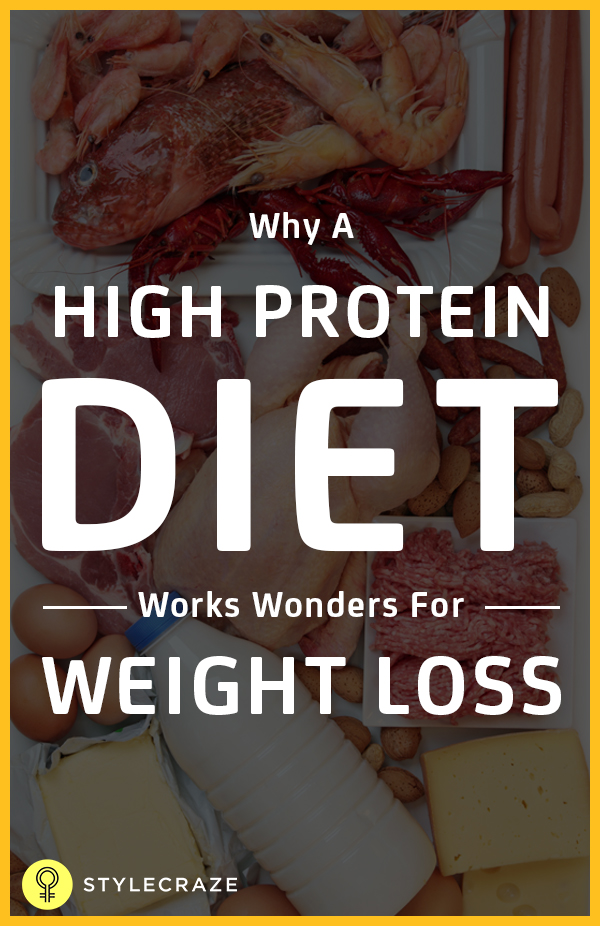

Now that you are armed with what protein can do to our midsection, a high protein diet and probably a little exercise is all that you need to melt that fat. So why wait, start this high protein diet for weight loss today and share your experiences with us in the comments box below.
-
I Stopped Trying to Shrink Myself and Focused on Getting Stronger—and I Look Great
Before: 215 After: 145 T
-
Why healthy fat foods are good for weight loss
-
The Set Point of Losing Weight
It’s May, and you’d have to be living in a cave not to notice the cons
-
10 WAYS TO LOSE STUBBORN FAT
10 Ways To Lose Stubborn Fat “I’ve tried everything to lose we
-
Burn calories with these rollout exercises
-
Are 30-Minute Fitness Classes Enough to Help You Lose Weight?
The 30-minute workout is gaining serious popularity. The indoor cyclin
- DON'T MISS
- Get results with this online weight loss diary
- Fashionable nutrition myths: The ‘eat every 3 hours’ myth
- Add turmeric to meals for weight loss
- On A Quest To Lose Weight Overnight? These 8 Simple Steps Will Help You Achieve Your Goal!
- Why New Year’s Resolutions to Lose Weight Often End in Failure
- Cut calories with a healthier pie crust
- HOW TO LOSE WEIGHT NATURALLY? 10 SIMPLE LIFESTYLE CHANGES THAT WILL HELP
- Opt for a healthy happy hour
- How to get slim for summer
- Promoting a healthy body image for women today
